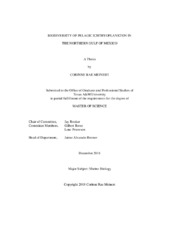| dc.description.abstract | Studies on larvae and juvenile fishes during the first few months of life are limited for many pelagic species despite the fact that biological data on these stages are needed to better assess and monitor recruitment variability and population-level processes. An increase in biological diversity in marine environments enhances ecosystem services and stability, increasing the overall health of the ecosystem. The aim of this study was to describe larval fish assemblages in pelagic waters of the northern Gulf of Mexico (NGoM) and identify environmental conditions associated with areas of increased taxonomic richness (TvF) and Shannon diversity (H’) (i.e., hotspots). Summer ichthyoplankton surveys were conducted in the NGoM in June and July 2015 and 2016 using neuston net (0-1m) and oblique bongo net (0-100m) tows conducted during the daytime (0700 – 1800 h). Overall, 17,091 fish larvae (N= 9,551 in 2015 and N= 7,540 in 2016) comprised of 99 families were collected over two years of sampling in the NGoM. The catch composition in the upper 1 m of the water column from neuston tows (i.e., surface layer sample) was relatively similar to the catch composition in the upper 100-120 m of the water column from oblique bongo tows (i.e., mixed layer sample), with carangids [jacks], scombrids [mackerels, tunas] and exocoetids [flyingfishes]) being numerically dominant; however, deep pelagic species (e.g. myctophids [lanternfishes], gonostomatids [bristlemouths], and sternoptychids [marine hatchetfishes]) were almost exclusively present in the mixed layer samples. Generalized additive models were used to evaluate the effect of oceanographic conditions on the abundance, TF, and H’. Several environmental variables (salinity, sea surface height) were found to be influential in explaining areas of high TvF and H’. Higher larval abundances, vTF, and H’ were found in water masses with lower salinity and lower sea surface height, which generally occurred along the northern stations sampled. This study highlights the NGoM as important habitat for larval fishes and suggests that oceanographic conditions are influential in determining assemblage structure in the region. | en |


